In Silicon Valley, startups usually become profitable only after raising and spending quite a lot of money. However, a post by Paul Graham from Y Combinator on how to be "ramen profitable" discusses a lot of tactics and strategies around how businesses can have a different form of profitability than what startups have traditionally aimed for. To be ramen profitable means to make just enough to pay the founders' living expenses.
In the business world of retail, restaurants, and hospitality, to bootstrap and to be ramen profitable from day one is the norm, as it is traditionally harder to raise capital for your business. There is often a higher upfront investment, but the advantage of running a retail business is that it is often associated with better cash flows, as compared to Silicon Valley startups.
My first business while I was in college was starting a Thai food business, Treehouse Restaurant. I founded the restaurant with two of my college friends, Elizabeth and Alicia. Over the course of 6 months, we came up with a business plan to start the business, hired over 20 part-time helpers and a chef, and launched the business exactly today 10 years ago. It was my second entrepreneurial experience, but it was also one of my most fun and interesting business startups. As I had limited capital in the early days of starting up the business, my teammates and I came up with creative ways to bootstrap and start Treehouse Restaurant. Here is what we did:
1. We bought equipment from a second-hand business
To start a restaurant, there are many pieces of hardware or equipment that you will need - from tables, chairs, ovens, stoves, pots, pans, culinary, to a cash register (I thought about not buying this, but my co-founders convinced me otherwise)!
The cost of purchasing these brand-new equipment could have easily cost more than $100,000. However, we did not have that much capital and hence, went around conducting massive research online to purchase the most reliable ones at a more reasonable price from different second-hand businesses, vendors, and companies. We actually managed to procure an older cash register that has been used by three other businesses but still worked perfectly well. For tables and chairs, we took a drive down to IKEA where we were able to purchase furniture at reasonable prices and self-assembled most of them with our friends and family.
2. Hire for excellence, not experience
Other than purchasing equipment and hardware, the cost of hiring is one of the biggest costs and barriers to starting a retail business. Having to hire on a shoestring budget, I was not able to look for people with extensive years of experience. Instead, I sought to hire candidates who were hungry, passionate, and eager to learn. In short, I was planning to hire for excellence, not experience.
To do this, I sourced out for applicants the traditional way by posting on the classified jobs section in various local newspapers and managed all my hiring on an excel spreadsheet. I manually used my phone to text these applicants and called them to coordinate over 100 back-to-back in-person interviews in the course of 4 weeks so I could have a good sense of who is a good culture fit for the team. I also devised different questions using online forms for the initial screening phase to have a better understanding of their availability, personality fit, and skillsets.
My experience in hiring hourly workers for my Thai food restaurant was also one of the inspirations for me to start Workstream today as I personally witnessed and felt the pain of hiring and onboarding hourly retail workers.
3. We created a menu that overlapped different ingredients
In order to keep the cost of goods low, we devised a menu that had at least 50% overlapping ingredients for every single main dish that we were selling and tried to limit the number of main dishes to less than seven dishes. For example, we would use the same chicken meat for Tom Yum Curry Chicken, Pineapple Fried Rice, and Pad Thai, and will also use the same peanuts and vegetables for different dishes as much as possible.
We also tried to outsource the drinks and desserts that we sold by procuring them from a vendor whom we knew complemented our food well. This helped to reduce the costs and time from preparing the food on our own.
4. We standardized operations and created a Just-in-Time strategy for our supplies and food
Similar to the Just-in-Time manufacturing standards popularized by Toyota, McDonald's, and General Motors, I standardized operations in the team such that there were structured steps. This way, any new employee who joins the team will be able to get up to speed with just 2 days of training and will be able to work full-time with the team efficiently. We created online tutorials and made them into videos by recording them so that people will be able to watch them at their own pace.
We also created a Just-in-Time strategy for our supplies and food to ensure that minimal food will be wasted everyday (and if there was wastage, we donated them to the local YMCA). This was an important strategy as food waste is one of the highest costs for any food business.
5. We limited opening hours
This may sound simple, but I do believe in the 80/20 rule, in which 80% of the business came in at lunchtime and dinnertime. By simply trying to limit the opening hours, I was able to reduce the cost of labor, electricity, and resources that could have been more leveraged during the busy periods. We also closed on Mondays to give everyone a break to re-energize and focused our efforts on the timings of the week that had the most business.
Overall, bootstrapping and starting a restaurant was one of the most fun entrepreneurial journeys I have ever gone on. This involved dressing up as a tree (think Treehouse restaurant) to learning to hire many people in a very short amount of time, and learning to manage our finances and operations. It was definitely one of the more meaningful experiences of my life, and it has laid the foundation for me to work on Workstream to impact and transform the hiring experiences for companies hiring hourly workers.




